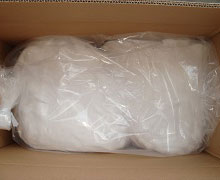Project Description

Features
Nano SiO2 has the features of small particle size, narrow particle size distribution, porous, large surface area and owns a large number of hydroxyl groups and unsaturated residual bonds on its surface and shows high reflectivity to long wave,visible light and ultraviolet ray.
Test Methods
Tested by BET method,silica nanoparticle has large specific surface area.Through infrared spectroscopy method, SiO2 nanoparticle exists a large number of hydroxyl groups and unsaturated residual bonds on its surface, and forms the deviation from the steady state of the silicon oxide structure.
According to the Cary-5E spectrophotometer test, silica dioxide nanoparticle shows high reflectivity to long wave,visible light and ultraviolet ray.
By using omnisorp100CX surface area and porosity analyzer, P-type nano-silica surface contains a number of nano-porous with the pore rate of 0.611ml /g.
Specification
| Item | Product Name | APS | Purity | Morphology | Color |
|---|---|---|---|---|---|
| EPRUI-SP15 | Nano SiO2 | 15nm | 99.5%+ | Amorphous | white |
| EPRUI-SP30 | Nano SiO2 | 30nm | 99.5%+ | Amorphous | white |
Applications
- Used in paint: on the basis of the original formulation of latex water paint, add SiO2 nanopowder which made up of 0.3-1% of the total weight (fully dispersed). By adding SiO2 nanoparticles, the performance of suspension stability, thixotropy of the coating, the strength of combination between substrate and coating and the degree of finish etc. has improved greatly. Also, the drying time is significantly shorten, the test time to artificially accelerate UV aging is multiplied, the scrub resistance increased from thousands of times to ten thousands of times and the stain resistance of the coating also improved significantly.
- Used in plastic: Silica nanoparticles is fully dispersed in polypropylene (PP), polyvinylchloride (PVC) plastic raw materials and can significantly improve strength, toughness, wear resistance and aging resistance of plastics. For example, nano modified PP, its performance in water absorption, insulation resistance, compressive residual deformation, flexural strength and other indicators all meet or exceed the engineering plastic nylon 6, and its weathering is more than doubled in some areas, and it can be an alternative to nylon 6 in some areas.
- Used in color rubber: By adding a small amount of nano sio2(instead of carbon black) in the solution polymerized styrene-butadiene and other rubber as reinforcing agents and anti-aging agent, the toughness, strength, elongation, bending and anti-aging performance of the color rubber products meet or exceed the EPDM.
- Used in modified magnetic materials: Add nano silicon oxide based composite powder into iron coke powder, the product performance reaches the highest level of the existing products according to the test. For example, the remanence flux density is more than 4100 Gs, inner intrinsic coercivity is greater than 3000 Oe and the magnetic energy product is greater than 4 mGOe, and the material production costs are significantly reduced at the same time.
- Used in cement concret
Traditional cement based material has low strength. By adding 2-5% silica nanoparticles instead of ordinary concrete materials, the performance of concrete will enhance.With special nano treatment,the surface area of nano silica can be larger, easier to cement and hydration in the formation of chemical bonds to CSH gel. Silica nanoparticles has a special network structure, On the basis of the original network structure of cement slurry, a new network is established to form a three-dimensional network structure, which can greatly improve the physical and mechanical properties and durability of cement paste. Therefore,nano SiO2 can be applied to high strength cement-based pavement materials.
In addition, nano silica can be widely used in the field of Tao (boring), porcelain, plaster, batteries, paints, adhesives, cosmetics, glass, steel, chemical fiber, plexiglass, and environmental protection to upgrade the quality.
EPRUI can also supply super hydrophobic nano SiO2.
